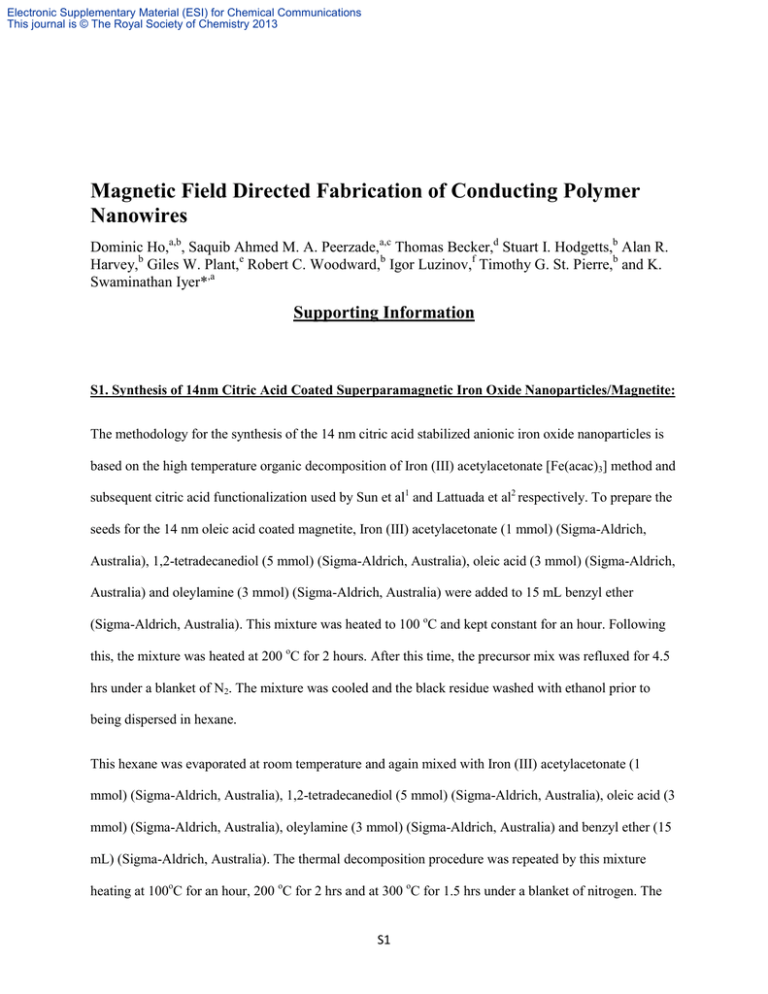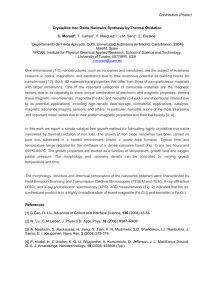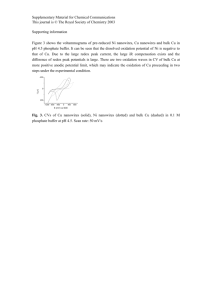Magnetic Field Directed Fabrication of Conducting Polymer Nanowires
advertisement

Electronic Supplementary Material (ESI) for Chemical Communications This journal is © The Royal Society of Chemistry 2013 Magnetic Field Directed Fabrication of Conducting Polymer Nanowires Dominic Ho,a,b, Saquib Ahmed M. A. Peerzade,a,c Thomas Becker,d Stuart I. Hodgetts,b Alan R. Harvey,b Giles W. Plant,e Robert C. Woodward,b Igor Luzinov,f Timothy G. St. Pierre,b and K. Swaminathan Iyer*,a Supporting Information S1. Synthesis of 14nm Citric Acid Coated Superparamagnetic Iron Oxide Nanoparticles/Magnetite: The methodology for the synthesis of the 14 nm citric acid stabilized anionic iron oxide nanoparticles is based on the high temperature organic decomposition of Iron (III) acetylacetonate [Fe(acac)3] method and subsequent citric acid functionalization used by Sun et al1 and Lattuada et al2 respectively. To prepare the seeds for the 14 nm oleic acid coated magnetite, Iron (III) acetylacetonate (1 mmol) (Sigma-Aldrich, Australia), 1,2-tetradecanediol (5 mmol) (Sigma-Aldrich, Australia), oleic acid (3 mmol) (Sigma-Aldrich, Australia) and oleylamine (3 mmol) (Sigma-Aldrich, Australia) were added to 15 mL benzyl ether (Sigma-Aldrich, Australia). This mixture was heated to 100 oC and kept constant for an hour. Following this, the mixture was heated at 200 oC for 2 hours. After this time, the precursor mix was refluxed for 4.5 hrs under a blanket of N2. The mixture was cooled and the black residue washed with ethanol prior to being dispersed in hexane. This hexane was evaporated at room temperature and again mixed with Iron (III) acetylacetonate (1 mmol) (Sigma-Aldrich, Australia), 1,2-tetradecanediol (5 mmol) (Sigma-Aldrich, Australia), oleic acid (3 mmol) (Sigma-Aldrich, Australia), oleylamine (3 mmol) (Sigma-Aldrich, Australia) and benzyl ether (15 mL) (Sigma-Aldrich, Australia). The thermal decomposition procedure was repeated by this mixture heating at 100oC for an hour, 200 oC for 2 hrs and at 300 oC for 1.5 hrs under a blanket of nitrogen. The S1 Electronic Supplementary Material (ESI) for Chemical Communications This journal is © The Royal Society of Chemistry 2013 magnetite was then cooled to room temperature, precipitated out with 40 mL ethanol and redispersed in hexane. This was repeated 3 times and the hexane left to evaporate overnight. 7.5 mL of both 1,2-dichlorobenzene and N,N’-dimethylformamide (total 15 mL) (Fluka, Australia and Merck, Australia respectively) was added to the dried magnetite, along with 180 mg of citric acid. The mixture was left stirring at 100 oC for 24 hrs. After this time, it mixture was cooled and precipitation of the magnetite induced by the addition of 40 mL of ethyl ether. The magnetite was then redispersed in acetone and reprecipated via centrifugation (3220G, 10 mins). The final precipitate was then dispersed and stored in water at room temperature. S2. Synthesis of PEDOT:PSS nanowires: The setup used to fabricate the nanowires consists of 2 NdFeB magnets (5 x 5 x 2 cm and 4.5 x 3 x 1 cm) with their field directions aligned and held 4 cm apart from each other. For magnetically forming wires, a sample vial was always placed in the centre of the field generated by the two magnets i.e. 2 cm from both magnets. The magnetic field strength at this position was determined to be 65 mT with a field gradient of 2.3 T/m towards the larger magnet. 1000 µl of magnetite suspension, with concentration of 0.2 mg/mL, was placed in between both magnets for 1 hr. 20 µl of 50 wt % of PEI (Mn = 1200, Mw = 1300. SigmaAldrich, Australia) was slowly added to the top of the sample vial, mixed via vortexing and placed between the magnets for another 2 hrs. After this time, excess PEI was removed via centrifugation and the wires resuspended in 500 µl of Milli-Q H2O. The nanowires were again realigned in the magnetic field for 1 hr followed by the slow addition of 10 µl of 1.3 wt % PEDOT:PSS (1.3 wt % dispersion in H2O, conductive grade with a conductivity of 1 S/cm. Sigma-Aldrich, Australia), which had been diluted with 500 µl of Milli-Q H2O, to the top of the sample vial and mixing via vortex before being placed between the 2 magnets for 3 hrs. Following this, the excess PEDOT:PSS was removed via centrifugation and the resulting nanowires resuspended in 500 µl of Milli-Q H2O. S2 Electronic Supplementary Material (ESI) for Chemical Communications This journal is © The Royal Society of Chemistry 2013 S3. Characterization: S3.1 Transmission electron microscopy (TEM) S3.1.1 Nanoparticle sizing and size distribution Synthesized iron oxide nanoparticles were drop-casted on carbon coated TEM grids and imaged with an accelerating voltage of 80 kV on a JEOL 2000 FX TEM- transmission electron microscope. To determine particle size distribution, 4 images were taken at a magnification of 20K x. The “Analyze Particles” function on ImageJ software (version 1.44p, National Institute of Health, USA) was used to determine the area of each particle in each image. Particles with an area of 2 – 500 nm2 and circularity of 0.5-1 were selected for analysis. From the measured areas of each particle, the radius and hence the diameter of each particle was determined. These results were tallied in a histogram (Figure S1). S3.1.2 Visualization of PEI encapsulated nanowires A 6 µl aliquot of PEI encapsulated nanowires suspension was placed onto a carbon coated holey grid. The grid was subsequently placed in the magnetic setup used to fabricate the nanowires (S2) until the droplet had dried. The imaging was conducted with an accelerating voltage of 80 kV on a JEOL 2100 TEM. S3.2 Dynamic light scattering (DLS) and zeta potential measurements DLS experiments were performed using a Malvern Zetasizer Nano series. For measuring the size, 5 measurements were taken and in each measurement there were 10 data acquisitions. Zeta potential (ζ) measurements were performed using the same instrument. Measurements for each sample were recorded in triplicate and 100 data acquisitions were recorded in each measurement. All measurements were recorded at 25oC in Malvern disposable clear Folded Capillary Cells. S3 Electronic Supplementary Material (ESI) for Chemical Communications This journal is © The Royal Society of Chemistry 2013 S3.3 Fourier transform infrared (FTIR) spectroscopy Magnetic nanoparticles were analyzed after modification with PEI and PEDOT:PSS using FTIR spectroscopy. The IR spectrum of PEI showed peaks at 2932 cm−1 that can be attributed to asymmetric vibrations of the CH2 group, and the peak at 1455 cm−1 corresponding to in-plane bending of CH2 . The peaks for the bending vibration of the NH group and the stretching vibration of the C-N groups of PEI were observed at 1574 cm−1 and 1106 cm−1, respectively.4 Addition of the PEDOT:PSS layer resulted in a characterestic large peak at 1662 cm-1 that is attributed to skeletal vibrations involving stretching of the less strained C=C bonds from the aromatic rings of PSS.5 S3.4 Scanning electron microscopy (SEM) The final sample of fabricated nanowires was diluted by a factor of half and deposited onto a glass slide in the presence of the same magnetic field used in their fabrication. Nanowires were then imaged once a pattern had been dried. S3.5 Atomic Force Microscopy A Dimension 3100 AFM system (Bruker) with a Nanoscope IV controller (Bruker) was used to obtain the AFM images in Contact Mode, using Pt/Ir coated contact mode probes with a spring constant of 0.2 N/m (type SCM-PIC, Bruker). The scan parameters were adjusted to ensure reliable imaging with the smallest possible contact force setpoint. Data analysis was performed using the SPM analysis freeware Gwyddion (http://gwyddion.net)3. S3.6 Current-Voltage (I-V) Curve Measurements Two silver epoxy electrodes were painted onto the 2 ends of the interdigitated electrodes and the whole integration was connected to a potentiostat setup (Model EA161 potentiostat and ED201 Model e-corder 201, both from EDaq). 0.2 µl of 0.2 mg/mL nanowire suspension was deposited onto the electrode and subjected to voltage sweeps of -1 V to 1 V. The corresponding data was recorded on EChem software S4 Electronic Supplementary Material (ESI) for Chemical Communications This journal is © The Royal Society of Chemistry 2013 (v2.0.9). S3.7 Conductivity of Nanowires The conductivity of the nanowires was determined from the I-V curves (Fig 3b). The average gradient ( ) of the curve from measurements in triplicate was 8.97 x 10-7. The conductivity (σ) of a material can be determined using the below equation σ= (1) where, L is the distance between each interdigitated electrode (9 µm), R is the resistance of the material and A is the cross sectional area. The cross section area (A) was determined as follows: The mass of the sample added on the IDE was 4 x 10-8 g, using 0.2 µL of 0.2 mg/ml suspension. The total volume of the material on the IDE was 8 x 10-15 m3. This was calculated using the density of magnetite, 5 g/mL . The volume of single nanowire was 0.187 x 10-18 m3 calculated using the average nanowire diameter (162 nm), obtained from AFM profile analysis. Total number of wires per analysis was approximated by dividing the total volume by volume per nanowire. This was determined to be 42689. This number of halved to account for the fact the distance between electrodes was same the width of the electrodes. So the total number of wires was assumed to be 21344. Total cross sectional area (A) was obtained by multiplying AFM cross sectional area of each wire by the number of wires. This was subsequently factored into equation (1), giving a conductivity of 1.7 x 10-4 S/cm for 0.2 µL of 0.2 mg/ml nanowire suspension. Supporting Figures S5 Electronic Supplementary Material (ESI) for Chemical Communications This journal is © The Royal Society of Chemistry 2013 Figure S1. Particle size distribution of the citric acid stabilized anionic iron oxide nanoparticles, mean diameter of 12.7 ± 3.2nm. S6 Electronic Supplementary Material (ESI) for Chemical Communications This journal is © The Royal Society of Chemistry 2013 Figure S2. Zeta potential measurements of the nanowires at various stages of fabrication: (a) free citric acid coated magnetite (ζ = -17.6 mV) (b) PEI adsorption onto nanowires (ζ = 44.3mV) (c) After PEDOT:PSS addition (ζ = -20.7 mV). Each sub-figure has 3 graphs as each measurement was carried out in triplicate. (a) (b) (c) S7 Electronic Supplementary Material (ESI) for Chemical Communications This journal is © The Royal Society of Chemistry 2013 References: (1) Sun, S.; Zeng, H.; Robinson, D. B.; Raoux, S.; Rice, P. M.; Wang, S. X.; Li, G. J. Am. Chem. Soc. 2004, 126, 273. (2) Lattuada, M.; Hatton, T. A. Langmuir 2006, 23, 2158. (3) Nečas, D.; Klapetek, P. Cent. Eur. J. Phys. 2012, 10, 181. (4) Yang,T.; Hussain, A.; Bai, S.; Khalil, I. A.; Harashima, H.; Ahsana, F. J Control Release. 2006 115(3): 289–297. (5) Stefanescu, E. A.; Tan, X.; Lin, Z; Bowler, N.; Kessler, M.R. Polymer 52 (2011) 2016-2024. S8








